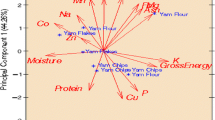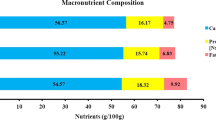Abstract
Proximate composition, total dietary fiber and pH of tomatillos (Physalis ixocarpa) grown in Baja, California were analyzed. Moisture content averaged 92%. On a dry matter basis (DMB), tomatillos contained 11% protein, 18% fat, 13% ash and 5% total dietary fiber. On an as consumed basis (ACB), tomatillos contained 1% protein, 1.5% fat, 1% ash and 0.4% dietary fiber. Carbohydrate (CHO) content was calculated by difference resulting in an average adjusted CHO (excluding dietary fiber) of 53% on a DMB and 4% on an ACB; total CHO (including dietary fiber) was 58 and 4.8%, respectively. Average kcalorie content was calculated to be about 31 kcals/100 g. The average pH of tomatillos was 3.76.
Similar content being viewed by others
References
Cartujano-Escobar F, Jankiewicz LS, Fernandez-Orduna VM, Mulato-Brito J, Pietkiewicz S (1987) Development of the husk tomato plant (Physalis ixocarpa Brot.), III: Growth analysis. Acta Societatis Botanicorum Poloniae 56: 421–436.
Mason A (1991) Personal communication. Cooperative Extension Service, Purdue University, West Lafayette, Indiana, USA.
Grijalva P (1991) Personal communication. Cooperative Extension Service New Mexico State University, Las Cruces, New Mexico, USA.
AOAC (1984) Official Methods of Analysis, 12th ed. Richmond, VA: William Byrd.
Prosky L, Asp NG, Furda I, Devries JW, Schweizer TF, Harland BF (1984) Determination of total dietary fiber in foods and food products. Paper presented at the AOAC Meeting, Washington, DC.
US Department of Agriculture (1991) Complete guide to home canning. Washington, DC: USDA, Bulletin No. 539.
Sapers GM, Phillips JG, Divito AM (1984) Correlation between pH and composition of foods comprising mixtures of tomatoes and low-acid ingredients. Food Sci. 49: 233–238.
Kirk RS, Sawyer R (1991) Pearson's composition and analysis of foods, 9th ed. London: Longman Scientific & Technical.
Stone MB, Soliah L, Craig J (1982) Ascorbic acid content, pH and acceptibility of home-canned tomatoes. Plant Foods Hum Nutri 31: 327–332.
US Department of Agriculture (1963) Composition of foods: Raw, processed, prepared. Washington, DC: USDA, Agriculture Handbook 8.
US Department of Agriculture (1975) Nutritive value of american food. Washington, DC: USDA, Agriculture Handbook 456.
US Department of Agriculture (1982) Composition of foods: Vegetables and vegetable products. Washington, DC: USDA, Agriculture Handbook 8.
Ramos D (1991) The safety of Chile salsas made with selected levels of tomatoes, vinegar and sugar using the water-bath canning process. MD Thesis. Las Cruces, NM: New Mexico State University.
McKee LH (1992) Personal communication. New Mexico State University, Las Cruces, New Mexico, USA.
Author information
Authors and Affiliations
Rights and permissions
About this article
Cite this article
Bock, M.A., Sanchez-Pilcher, J., McKee, L.J. et al. Selected nutritional and quality analyses of tomatillos (Physalis ixocarpa). Plant Food Hum Nutr 48, 127–133 (1995). https://doi.org/10.1007/BF01088308
Received:
Accepted:
Issue Date:
DOI: https://doi.org/10.1007/BF01088308




